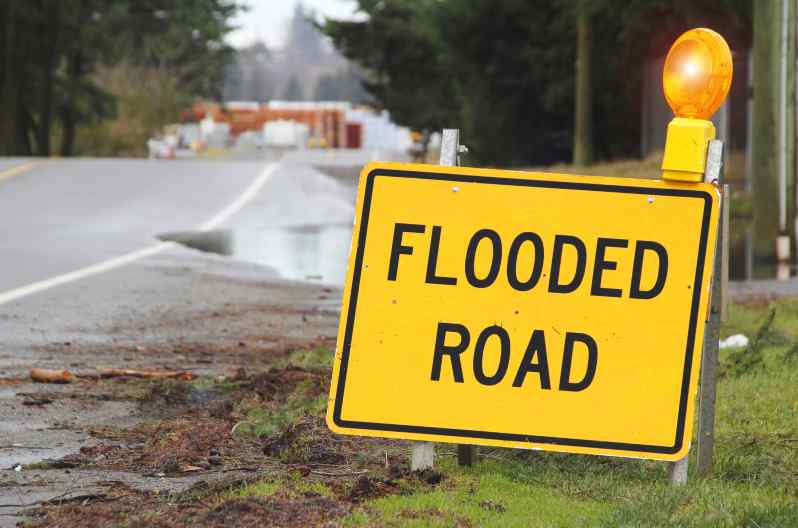Flash floods are an extremely devastating force of nature. They can form in just minutes and cover great distances in a short time. This makes them one of the leading causes of flood damage. We look at what causes flash floods as well as ways to stay safe if a flood warning is issued. Plus, we look at how to clean up after a flash flood.
What is a Flash Flood?
Flash floods are caused by sudden storms when the soil is unable to absorb the rainwater. While wet and saturated soil is often to blame for flash flooding, extremely dry soil can produce them as well. As a result, the water remains on top of the ground. This creates powerful, fast-moving channels of water. We look at the causes as well as how to clean up flash flood damage.
What Causes Flash Floods?
Unfortunately, flash floods are the leading cause of severe weather-related deaths. For that reason, it’s important to know what causes a flash flood and what to do if a flood alert is issued in your area. Common causes of flash flooding include:
- Heavy rain in a short period of time, such as a sudden downpour
- Rain over an extended period of time, such as a hurricane or tropical storm
- Rapid thaws that cause significant snowmelt
- A failure of a dam or levee
- A sudden release of water held by an ice jam
- Overwhelmed man-made storm drains or sewers
What Areas Have the Greatest Risk for Flash Floods?
Although Florida and Louisiana are most prone to flooding, flash floods can occur anywhere and often happen with little or no warning. Floods are also common in these areas:
- Near naturally occurring water sources, like rivers and lakes
- Downstream from a dam, levee, or another water barrier
- Near dry water beds, like creeks, streams, rivers and gullies
What is the Difference Between a Flood Watch and a Flood Warning?
- Flood Watch: A flood watch means the conditions are right and a flood could develop at any time.
- Flood Warning: A flood warning means there is a flood or one is imminent within the next 30 to 60 minutes.
5 Tips for Remaining Safe During Flash Floods
In most cases, you will only have a few minutes to take action if a flash flood warning is issued for your area. That’s why it’s important to know what to do if a flash flood warning is issued.
1. Follow Instructions from Local Authorities
Always follow instructions from local authorities, especially if a mandatory evacuation order is given. Go to a designated evacuation shelter or seek high ground away from sources of water like rivers and lakes. Do return to your home until floodwaters have receded and local authorities issue an all-clear.
2. Stay Safe If Your Remain In Your Home
If an evacuation order is not given and you choose to remain in your property, close all windows and doors and take shelter in the highest possible area. Stay tuned to weather reports and emergency signals and wait for the all-clear before leaving your home.
3. Stay Clear of Water Sources
Any source of water can easily overflow and causing a flash flood scenario or making one worse. If you have a stream or creek running through your property, keep a close eye on it and be prepared to get out of its way if the levels begin to rise. The same goes for man-made water sources like storm drains and drainage ditches.
4. Avoid Driving Through Flooded Areas
Most flood-related deaths are the result of people trapped in their vehicles, so you should never attempt to drive through a flooded area. If you are in your car when a flash flood warning is issued, pull over and move to high ground. Make sure you take your phone with you, should you need to call for assistance.
5. Avoid Walking in Flood Waters
Likewise, you should never attempt to walk through floodwaters. Floodwaters are extremely powerful and it only takes six inches of moving water to knock a grown adult off their feet. Under no circumstances should you attempt to outrun a flood. Instead, seek higher ground immediately. Also, be especially cautious at night, as water threats are more difficult to discern in the darkness.
How to do You Cleanup a Flash Flood?
The flash flood cleanup process involves removing the water and drying your home as quickly as possible. Whether you are doing the work yourself or hiring a restoration contractor, these are the basic steps to follow:
- Remove Floodwaters: Use a pump to remove floodwaters from your home. Make sure the pump drains water away from your home or it could cause more flooding.
- Dispose of Damaged Items: Throw away items that are damaged and cannot be saved. This includes personal items and furniture as well as walls and carpeting.
- Dry Your Home: Use high-volume fans and dehumidifiers to dry the structure of your home. Depending on the damage, drying time should take between 12 and 36 hours.
- Clean, Disinfect and Deodorize: Clean dirt using soap and warm what, then kill mold with a bleach solution. For odors, use baking soda to absorb smells.
- Rebuild Damaged Areas: Finally, install new carpeting and drywall or refinish damaged wood.
If you hire a restoration company like Restoration Local, they will usually follow these same steps. However, they will use slightly different equipment and cleaners. The advantage is a faster, more thorough cleanup.
If you need help cleaning up a flash flood, Restoration Local is here to remove the water fast. Call 1-888-443-3110 for 24 hour service and a free estimate on flood damage restoration services. Our restoration specialists are experienced in cleaning up flash floods and have the tools to restore your home fast.





